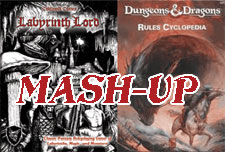So, I haven't been very active here on the ol' blog, you may have noticed. Not that I ever was. :-)
I've always had a fairly severe case of Gamer ADD and seem to flit from project to project, interest to interest, so it's hard to ever finish anything. Still, I stay interested in a couple of projects - both my cyberpunk game and developing Trevail, my gameworld. Part of the problem is that I have two systems I want to write for. Swords & Wizardry: WhiteBox is awesome and I want to support it by eventually publishing both projects as supplements for that game. But my true love for a system is still Rules Cyclopedia! GRRR!
As my post title implies, I'm actually running a tabletop game, so while the cyberpunk project sits dormant, I
am working on stuff for Trevail. We've been playing for almost 5 months now, meeting weekly, except for the occasional week we needed to skip. Not bad right? My group consists of four players. Three kids, one mine, and a couple friends, plus an older friend of mine. My friend Rich, and Paul (one of the kids) have some gaming experience, both with AD&D second edition. My daughter Shannon has some BECMI under her belt, and Robyn, our fourth only had a bit of online RPG experience. All in all a mixed bag of gaming experience and maturity, so it's been a challenge as a fairly inexperienced DM.
To start things off relatively simply for the beginners, I chose WhiteBox as our system. In pre-game discussions, Paul indicated he wanted to play a Bard, and of course there wasn't one for WB. I did some research and found some examples, plus looked at 2E, since that's what he was used to playing, and eventually bashed something up. Since the Bard is a thief variant in 2E, I ended up working up one of those too, again based on other things I found outline. Never satisfied, I've continued to tweak them to a level I felt fit the WB presentation and I think I'm pretty happy with them now. Also working on orcs as a playable race.
I'e also been working on some maps, trying to flesh out a small sandbox region for the group to explore. I plug in small adventures try to seed rumors for the party to follow. One great source has been the awesome maps by
Dyson Logos. I strongly recommend you check them out if you haven't heard of him yet. That awesome city map over there is going to be fleshed out as the major city in the region I'm detailing. I'm using
Haldane as a template for how I want to do that.
As a group, they seem to have taken to the game and ruleset and I've already talked about rolling the game over to Rules Cyclopedia. For the most part, it will be a mostly transparent change for them, I think, and will let me run the system I really want to be using. I'm not ready to do it right away, but it will happen once I'm ready.
So where does that leave us here? I'm going to try and be more active on the blog as a way to force myself to keep working on the game. I'm going to post my WB classes, and eventually compile it into a supplement form
ala Greyhawk or Blackmoor were for OD&D. It may be just houserules and classes - rules stuff like those old supplements were - and eventually work in the setting stuff, more like
Rob Conley's Blackmarsh, though I doubt it'll ever be that good... I also would like to post some game night pics and session report type things.
Finally, I'll need to work up some of this stuff for Rules Cyclopedia - a Bard, which will be more like the 2E one and less like the WB one, a couple orc classes, some elven variations...
Stay tuned!





